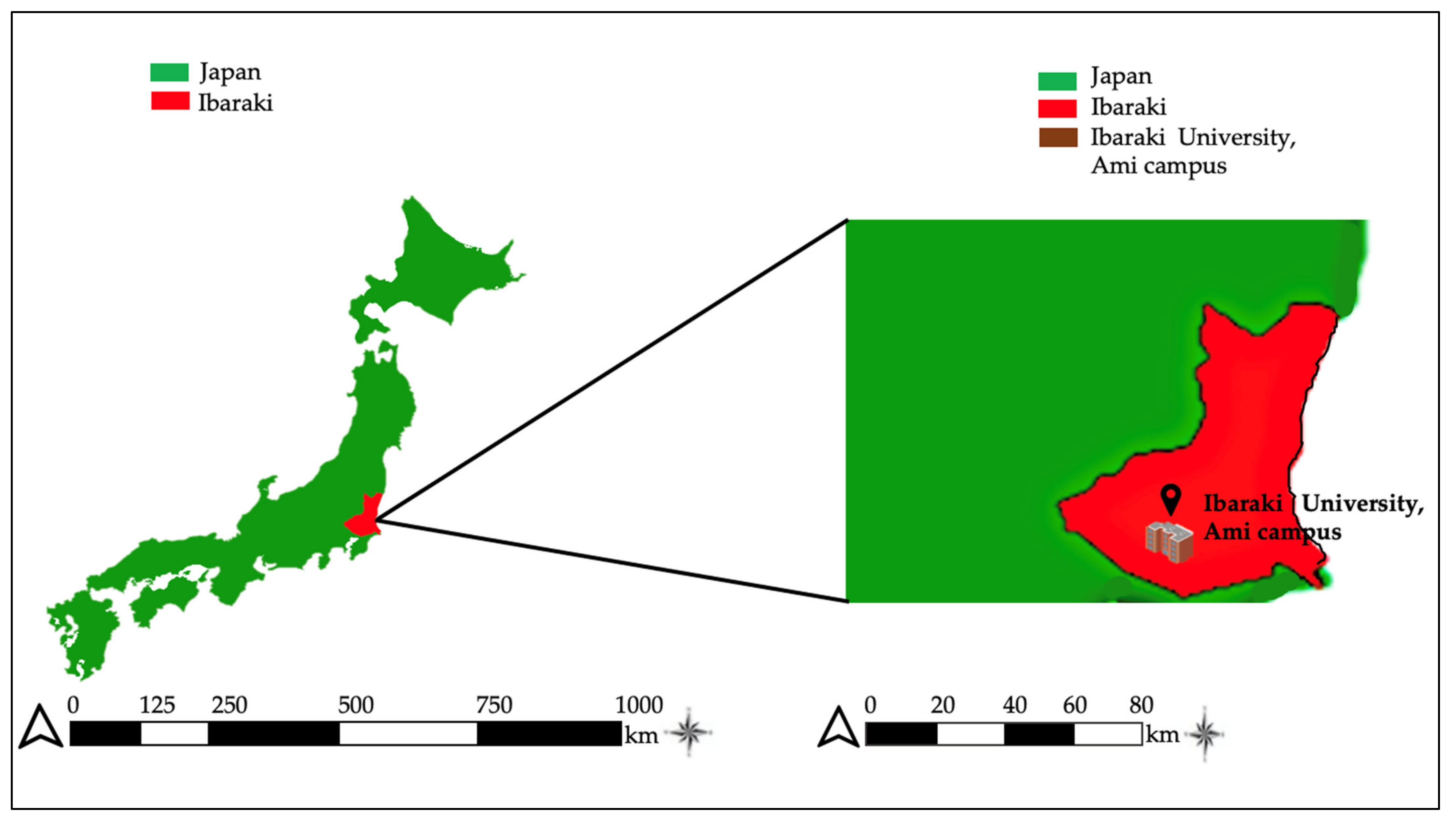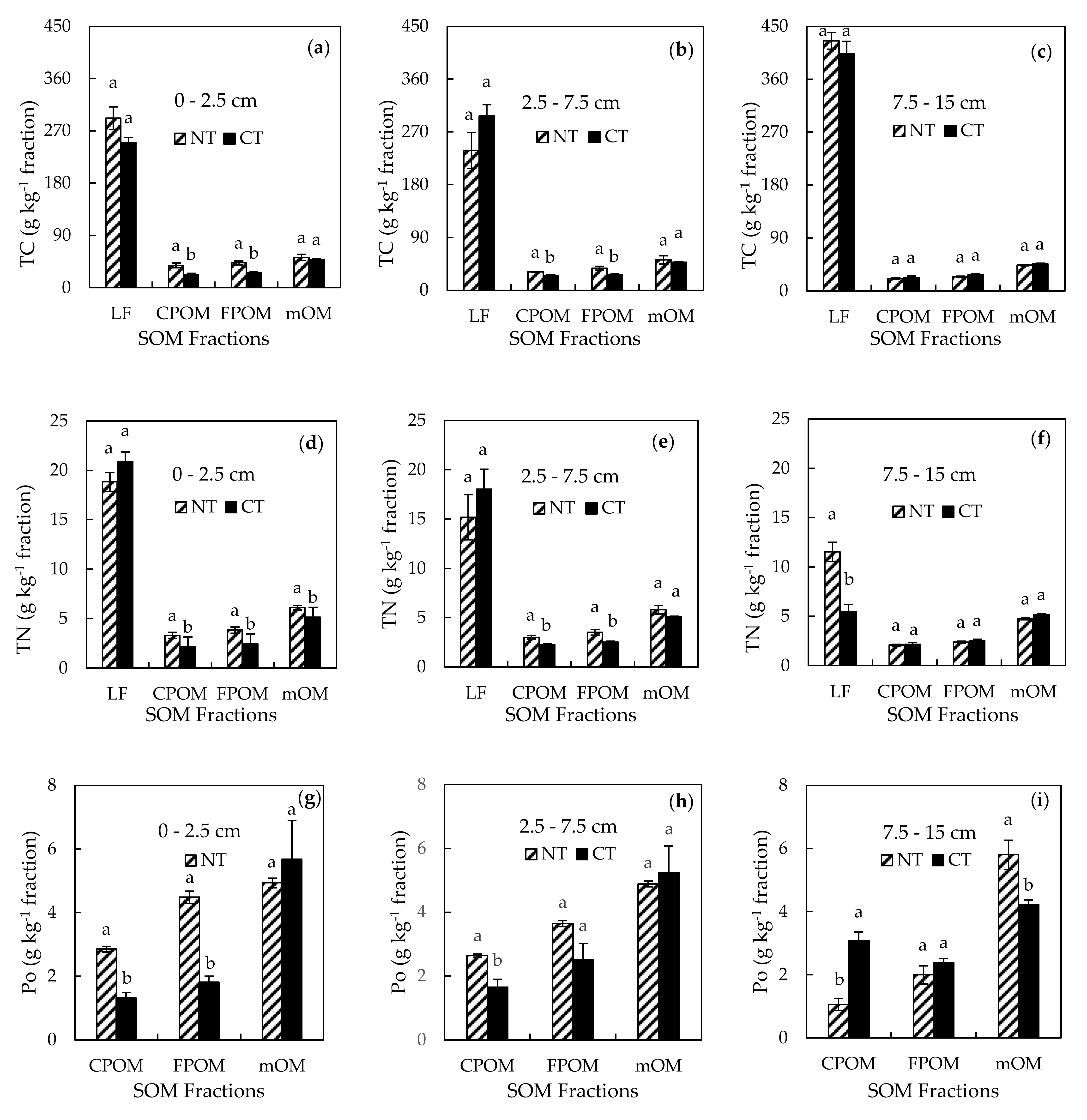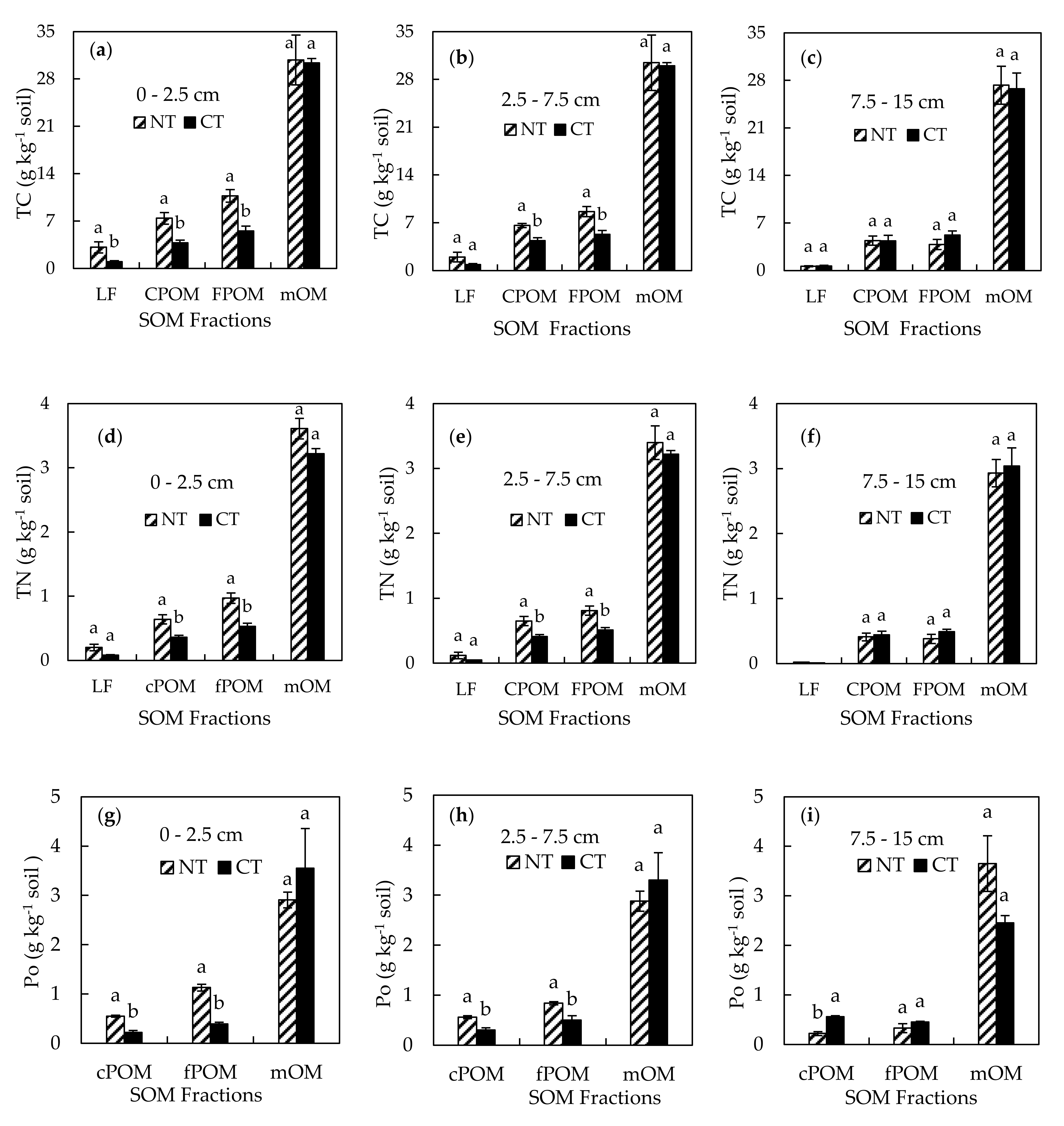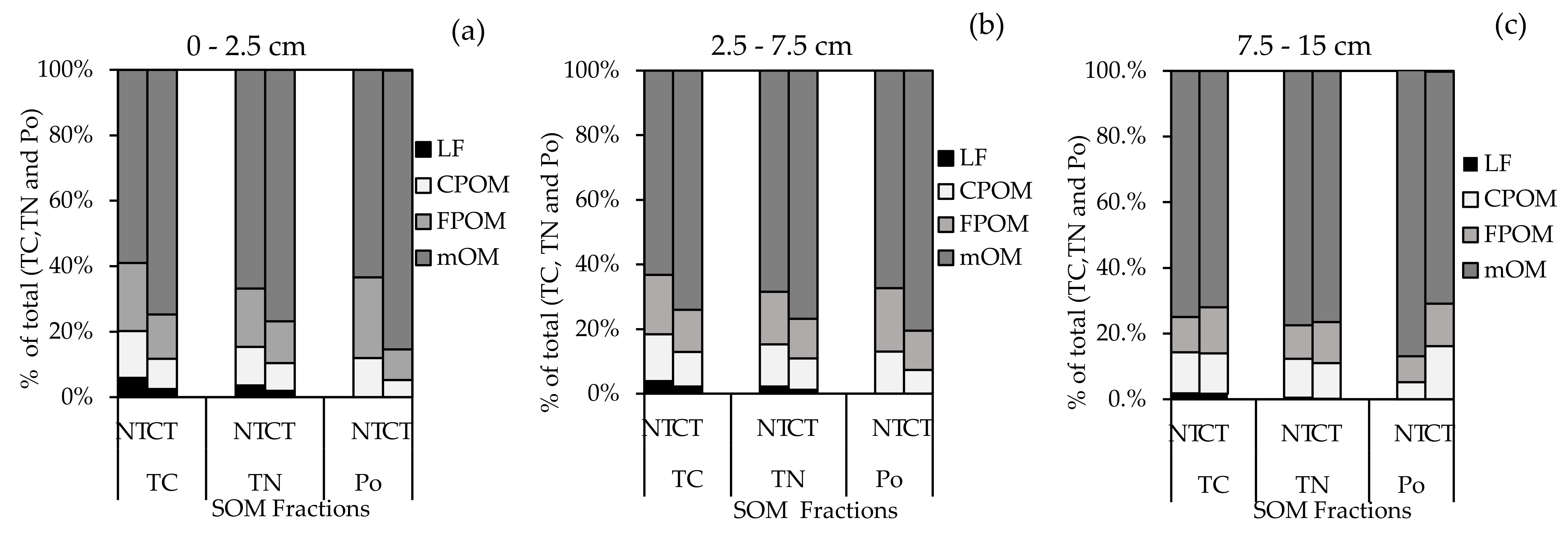No Tillage Increases SOM in Labile Fraction but Not Stable Fraction of Andosols from a Long-Term Experiment in Japan
Abstract
:1. Introduction
2. Materials and Methods
2.1. Research Site and Experimental Design
2.2. Soil Sampling and Analysis
2.3. Physical Fractionation and Chemical Analysis of Soil Organic Matter
2.4. Statistical Analysis
3. Results
3.1. TC, TN, and Po in Fractionated OM and Its Contribution to Its Total Amount in the Soil
3.2. SOC Stock in the Fractionated OM under Different Tillage Management Systems
3.3. C:N, C:Po, and N:Po Ratio of SOM Fractions
4. Discussion
4.1. Effect of No Tillage on Physically Fractionated C, N, and Po in Andosols
4.2. Effect of No Tillage on Fractionated OM Quality in Andosols
5. Conclusions
Supplementary Materials
Author Contributions
Funding
Data Availability Statement
Acknowledgments
Conflicts of Interest
References
- Weil, R.R.; Brady, C.N. Nature and Properties of Soils, 15th ed.; Pearson Education Limited: London, UK, 2017. [Google Scholar]
- Lal, R. Soil carbon sequestration impacts on global climate change and food security. Science 2004, 304, 1623–1627. [Google Scholar] [CrossRef] [PubMed] [Green Version]
- Lal, R. Carbon emission from farm operations. Environ. Int. 2004, 30, 981–990. [Google Scholar] [CrossRef] [PubMed]
- Komatsuzaki, M.; Ohta, H. Soil management practices for sustainable agro-ecosystems. Sustain. Sci. 2007, 2, 103–120. [Google Scholar] [CrossRef]
- Sachs, J.; Schmidt-Traub, G.; Kroll, C.; Lafortune, G.; Fuller, G.; Woelm, F. Sustainable Development Report 2020: The Sustainable Development Goals and Covid-19 Includes the SDG Index and Dashboards. In Sustainable Development Report 2020; Cambridge Books: Cambridge, UK, 2021. [Google Scholar] [CrossRef]
- Six, J.; Feller, C.; Denef, K.; Ogle, S.M.; De Moraes Sa, J.C.; Albrecht, A. Soil organic matter, biota and aggregation in temperate and tropical soils-Effects of no-tillage. Agronomie 2002, 22, 755–775. [Google Scholar] [CrossRef] [Green Version]
- Paul, E.A.; Paustian, K.H.; Elliott, E.T.; Cole, C.V. Soil Organic Matter in Temperate Agroecosystems; CRC Press: Boca Raton, FL, USA, 2019. [Google Scholar] [CrossRef]
- Six, J.; Elliott, E.T.; Paustian, K. Aggregate and Soil Organic Matter Dynamics under Conventional and No-Tillage Systems. Soil Sci. Soc. Am. J. 1999, 63, 1350–1358. [Google Scholar] [CrossRef] [Green Version]
- Eswaran, H.; Berg, E.; Van Den Reich, P. Organic Carbon in Soils of the World. Soil Sci. Soc. Am. J. 1993, 57, 192–194. [Google Scholar] [CrossRef] [Green Version]
- Pubs.GISS: Hillel and Rosenzweig 2009: Soil Carbon and Climate Change: Carbon Exchange in the Terrestrial. Available online: https://pubs.giss.nasa.gov/abs/hi05100g.html (accessed on 28 December 2021).
- Asano, M.; Wagai, R. Evidence of aggregate hierarchy at micro- to submicron scales in an allophanic andisol. Geoderma 2014, 216, 62–74. [Google Scholar] [CrossRef]
- Wada, K.; Higashi, T. The Categories of Aluminium and Iron-Humus Complexes in Ando Soils Determined by Selective Dissolution. J. Soil Sci. 1976, 27, 357–368. [Google Scholar] [CrossRef]
- Miyazawa, M.; Takahashi, T.; Sato, T.; Kanno, H.; Nanzyo, M. Factors controlling accumulation and decomposition of organic carbon in humus horizons of Andosols: A case study for distinctive non-allophanic Andosols in northeastern Japan. Biol. Fertil. Soils 2013, 49, 929–938. [Google Scholar] [CrossRef]
- Takahashi, T.; Yamada, K.; Kanno, H.; Nanzyo, M. Organic carbon accumulation in Andosols: (2)Contribution of aluminum-humus complexes to carbon accumulation in non-allophanic Andosols. J. Integr. F. Sci. 2010, 7, 69–72. [Google Scholar]
- Iwasaki, S.; Endo, Y.; Hatano, R. The effect of organic matter application on carbon sequestration and soil fertility in upland fields of different types of Andosols. Soil Sci. Plant Nutr. 2017, 63, 200–220. [Google Scholar] [CrossRef] [Green Version]
- Koga, N.; Shimoda, S.; Shirato, Y.; Kusaba, T.; Shima, T.; Niimi, H.; Yamane, T.; Wakabayashi, K.; Niwa, K.; Kohyama, K.; et al. Assessing changes in soil carbon stocks after land use conversion from forest land to agricultural land in Japan. Geoderma 2020, 377, 114487. [Google Scholar] [CrossRef]
- Hoshino, Y.; Higashi, T.; Ito, T.; Komatsuzaki, M. Tillage can reduce the radiocesium contamination of soybean after the Fukushima Dai-ichi nuclear power plant accident. Soil Tillage Res. 2015, 153, 76–85. [Google Scholar] [CrossRef]
- Wulanningtyas, H.S.; Gong, Y.; Li, P.; Sakagami, N.; Nishiwaki, J.; Komatsuzaki, M. A cover crop and no-tillage system for enhancing soil health by increasing soil organic matter in soybean cultivation. Soil Tillage Res. 2021, 205, 104749. [Google Scholar] [CrossRef]
- Ito, T.; Araki, M.; Komatsuzaki, M.; Kaneko, N.; Ohta, H. Soil nematode community structure affected by tillage systems and cover crop managements in organic soybean production. Appl. Soil Ecol. 2015, 86, 137–147. [Google Scholar] [CrossRef] [Green Version]
- Shirato, Y.; Hakamata, T.; Taniyama, I. Modified rothamsted carbon model for andosols and its validation: Changing humus decomposition rate constant with pyrophosphate-extractable Al. Soil Sci. Plant Nutr. 2004, 50, 149–158. [Google Scholar] [CrossRef]
- Jastrow, J.D.; Amonette, J.E.; Bailey, V.L. Mechanisms controlling soil carbon turnover and their potential application for enhancing carbon sequestration. Clim. Change 2007, 80, 5–23. [Google Scholar] [CrossRef]
- Nakamoto, T.; Komatsuzaki, M.; Hirata, T.; Araki, H. Effects of tillage and winter cover cropping on microbial substrate-induced respiration and soil aggregation in two Japanese fields. Soil Sci. Plant Nutr. 2012, 58, 70–82. [Google Scholar] [CrossRef] [Green Version]
- Higashi, T.; Yunghui, M.; Komatsuzaki, M.; Miura, S.; Hirata, T.; Araki, H.; Kaneko, N.; Ohta, H. Tillage and cover crop species affect soil organic carbon in Andosol, Kanto, Japan. Soil Tillage Res. 2014, 138, 64–72. [Google Scholar] [CrossRef]
- Gong, Y.; Li, P.; Lu, W.; Nishiwaki, J.; Komatsuzaki, M. Response of soil carbon dioxide emissions to no-tillage and moldboard plow systems on Andosols in a humid, subtropical climate, Japan. Geoderma 2021, 386, 114920. [Google Scholar] [CrossRef]
- Yagioka, A.; Komatsuzaki, M.; Kaneko, N.; Ueno, H. Effect of no-tillage with weed cover mulching versus conventional tillage on global warming potential and nitrate leaching. Agric. Ecosyst. Environ. 2015, 200, 42–53. [Google Scholar] [CrossRef]
- Koga, N. Tillage, fertilizer type, and plant residue input impacts on soil carbon sequestration rates on a Japanese Andosol. Soil Sci. Plant Nutr. 2017, 63, 396–404. [Google Scholar] [CrossRef]
- Cambardella, C.A.; Elliott, E.T. Particulate Soil Organic-Matter Changes across a Grassland Cultivation Sequence. Soil Sci. Soc. Am. J. 1992, 56, 777–783. [Google Scholar] [CrossRef]
- Six, J.; Elliott, E.T.; Paustian, K.; Doran, J.W. Aggregation and Soil Organic Matter Accumulation in Cultivated and Native Grassland Soils. Soil Sci. Soc. Am. J. 1998, 62, 1367–1377. [Google Scholar] [CrossRef] [Green Version]
- Sohi, S.P.; Mahieu, N.; Arah, J.R.M.; Powlson, D.S.; Madari, B.; Gaunt, J.L. A Procedure for Isolating Soil Organic Matter Fractions Suitable for Modeling. Soil Sci. Soc. Am. J. 2001, 65, 1121–1128. [Google Scholar] [CrossRef]
- Zotarelli, L.; Alves, B.J.R.; Urquiaga, S.; Torres, E.; Dos Santos, H.P.; Paustian, K.; Boddey, R.M.; Six, J. Impact of Tillage and Crop Rotation on Aggregate-Associated Carbon in Two Oxisols. Soil Sci. Soc. Am. J. 2005, 69, 482–491. [Google Scholar] [CrossRef] [Green Version]
- Wander, M. Soil organic matter fractions and their relevance to soil function. In Soil Organic Matter in Sustainable Agriculture; CRC Press: Boca Raton, FL, USA, 2004; pp. 67–102. [Google Scholar]
- Lavallee, J.M.; Soong, J.L.; Cotrufo, M.F. Conceptualizing soil organic matter into particulate and mineral-associated forms to address global change in the 21st century. Glob. Change Biol. 2020, 26, 261–273. [Google Scholar] [CrossRef] [Green Version]
- Álvaro-Fuentes, J.; López, M.V.; Cantero-Martinez, C.; Arrúe, J.L. Tillage Effects on Soil Organic Carbon Fractions in Mediterranean Dryland Agroecosystems. Soil Sci. Soc. Am. J. 2008, 72, 541–547. [Google Scholar] [CrossRef] [Green Version]
- Salvo, L.; Hernández, J.; Ernst, O. Distribution of soil organic carbon in different size fractions, under pasture and crop rotations with conventional tillage and no-till systems. Soil Tillage Res. 2010, 109, 116–122. [Google Scholar] [CrossRef]
- Wander, M.M.; Bidart, M.G.; Aref, S. Tillage Impacts on Depth Distribution of Total and Particulate Organic Matter in Three Illinois Soils. Soil Sci. Soc. Am. J. 1998, 62, 1704–1711. [Google Scholar] [CrossRef]
- Bayer, C.; Martin-Neto, L.; Mielniczuk, J.; Pavinato, A.; Dieckow, J. Carbon sequestration in two Brazilian Cerrado soils under no-till. Soil Tillage Res. 2006, 86, 237–245. [Google Scholar] [CrossRef]
- Kibet, L.C.; Blanco-Canqui, H.; Jasa, P. Long-term tillage impacts on soil organic matter components and related properties on a Typic Argiudoll. Soil Tillage Res. 2016, 155, 78–84. [Google Scholar] [CrossRef]
- Bayer, C.; Martin-Neto, L.; Mielniczuk, J.; Pillon, C.N.; Sangoi, L. Changes in Soil Organic Matter Fractions under Subtropical No-Till Cropping Systems. Soil Sci. Soc. Am. J. 2001, 65, 1473–1478. [Google Scholar] [CrossRef]
- Bayer, C.; Mielniczuk, J.; Martin-Neto, L.; Ernani, P.R. Stocks and humification degree of organic matter fractions as affected by no-tillage on a subtropical soil. Plant Soil 2002, 238, 133–140. [Google Scholar] [CrossRef]
- Parfitt, R.L.; Theng, B.K.G.; Whitton, J.S.; Shepherd, T.G. Effects of clay minerals and land use on organic matter pools. Geoderma 1997, 75, 1–12. [Google Scholar] [CrossRef]
- Pinheiro, É.F.M.; de Campos, D.V.B.; de Carvalho Balieiro, F.; dos Anjos, L.H.C.; Pereira, M.G. Tillage systems effects on soil carbon stock and physical fractions of soil organic matter. Agric. Syst. 2015, 132, 35–39. [Google Scholar] [CrossRef]
- LeBauer, D.S.; Treseder, K.K. Nitrogen limitation of net primary productivity in terrestrial ecosystems is globally distributed. Ecology 2008, 89, 371–379. [Google Scholar] [CrossRef] [Green Version]
- Vitousek, P.M.; Porder, S.; Houlton, B.Z.; Chadwick, O.A. Terrestrial phosphorus limitation: Mechanisms, implications, and nitrogen-phosphorus interactions. Ecol. Appl. 2010, 20, 5–15. [Google Scholar] [CrossRef] [Green Version]
- Wyngaard, N.; Vidaurreta, A.; Echeverría, H.E.; Picone, L.I. Dynamics of Phosphorus and Carbon in the Soil Particulate Fraction Under Different Management Practices. Soil Sci. Soc. Am. J. 2013, 77, 1584–1590. [Google Scholar] [CrossRef]
- Sugihara, S.; Shibata, M.; Mvondo-Ze, A.D.; Araki, S.; Kosaki, T.; Funakawa, S. Soil phosphorus of stable fraction differentially associate with carbon in the tropical forest and savanna of eastern Cameroon. Soil Sci. Plant Nutr. 2017, 63, 616–627. [Google Scholar] [CrossRef] [Green Version]
- Wyngaard, N.; Cabrera, M.L.; Jarosch, K.A.; Bünemann, E.K. Phosphorus in the coarse soil fraction is related to soil organic phosphorus mineralization measured by isotopic dilution. Soil Biol. Biochem. 2016, 96, 107–118. [Google Scholar] [CrossRef] [Green Version]
- Shoji, S.; Dahlgren, R.; Nanzyo, M. Chapter 3 Genesis of Volcanic Ash Soils. Dev. Soil Sci. 1993, 21, 37–71. [Google Scholar] [CrossRef]
- Takeda, M.; Nakamoto, T.; Miyazawa, K.; Murayama, T.; Okada, H. Phosphorus availability and soil biological activity in an Andosol under compost application and winter cover cropping. Appl. Soil Ecol. 2009, 42, 86–95. [Google Scholar] [CrossRef]
- Zhao, T.; Zhao, Y.; Higashi, T.; Komatsuzaki, M. Power Consumption of No-tillage Seeder under Different Cover Crop Species and Termination for Soybean Production. Eng. Agric. Environ. Food 2012, 5, 50–56. [Google Scholar] [CrossRef]
- Japan Meteorological Agency. Search for Past Weather Data. Available online: https://www.data.jma.go.jp/obd/stats/etrn/view/annually_s.php?prec_no=40&block_no=47646&year=2020&month=&day=&view= (accessed on 30 December 2021).
- FAO. World Reference Base for Soil Resources, 3rd ed.; FAO: Rome, Italy, 2015; Volume 4, ISBN 9789251083697. [Google Scholar]
- Diochon, A.; Gillespie, A.W.; Ellert, B.H.; Janzen, H.H.; Gregorich, E.G. Recovery and dynamics of decomposing plant residue in soil: An evaluation of three fractionation methods. Eur. J. Soil Sci. 2016, 67, 196–205. [Google Scholar] [CrossRef]
- Walker, T.W.; Adams, A.F.R. Studies on Soil Organic Matter: I. Influence of Phosphorus Content of Parent Materials on Accumulations of Carbon, Nitrogen, Sulfur, and Organic Phosphorus In Grassland Soils. Soil Sci. 1958, 87, 307–318. [Google Scholar] [CrossRef]
- Murphy, J.; Riley, J.P. A modified single solution method for the determination of phosphate in natural waters. Anal. Chim. Acta 1962, 27, 31–36. [Google Scholar] [CrossRef]
- Adams, J.L.; Tipping, E.; Thacker, S.A.; Quinton, J.N. An investigation of the distribution of phosphorus between free and mineral associated soil organic matter, using density fractionation. Plant Soil 2018, 427, 139–148. [Google Scholar] [CrossRef] [Green Version]
- Hassink, J.; Whitmore, A.P.; Kubát, J. Size and density fractionation of soil organic matter and the physical capacity of soils to protect organic matter. Eur. J. Agron. 1997, 7, 189–199. [Google Scholar] [CrossRef]
- Castellano, M.J.; Mueller, K.E.; Olk, D.C.; Sawyer, J.E.; Six, J. Integrating plant litter quality, soil organic matter stabilization, and the carbon saturation concept. Glob. Change Biol. 2015, 21, 3200–3209. [Google Scholar] [CrossRef]
- Baldock, J.A.; Skjemstad, J.O. Role of the soil matrix and minerals in protecting natural organic materials against biological attack. Org. Geochem. 2000, 31, 697–710. [Google Scholar] [CrossRef]
- Sangster, A.; Knight, D.; Farrell, R.; Bedard-Haughn, A. Repeat-pulse 13CO2 labeling of canola and field pea: Implications for soil organic matter studies. Rapid Commun. Mass Spectrom. 2010, 24, 2791–2798. [Google Scholar] [CrossRef] [PubMed]
- Comeau, L.P.; Lemke, R.L.; Knight, J.D.; Bedard-Haughn, A. Carbon input from 13C-labeled crops in four soil organic matter fractions. Biol. Fertil. Soils 2013, 49, 1179–1188. [Google Scholar] [CrossRef]
- Skjemstad, J.O.; Dalal, R.C. Spectroscopic and chemical differences in organic matter of two vertisols subjected to long periods of cultivation. Aust. J. Soil Res. 1987, 25, 323–335. [Google Scholar] [CrossRef]
- Dou, F.; Hons, F.M. Tillage and Nitrogen Effects on Soil Organic Matter Fractions in Wheat-based Systems. Soil Sci. Soc. Am. J. 2006, 70, 1896–1905. [Google Scholar] [CrossRef]
- Beare, M.H.; Hendrix, P.F.; Cabrera, M.L.; Coleman, D.C. Aggregate-Protected and Unprotected Organic Matter Pools in Conventional- and No-Tillage Soils. Soil Sci. Soc. Am. J. 1994, 58, 787–795. [Google Scholar] [CrossRef]
- Franzluebbers, A.J.; Arshad, M.A. Soil organic matter pools with conventional and zero tillage in a cold, semiarid climate. Soil Tillage Res. 1996, 39, 1–11. [Google Scholar] [CrossRef]
- Chen, H.; Liang, Q.; Gong, Y.; Kuzyakov, Y.; Fan, M.; Plante, A.F. Reduced tillage and increased residue retention increase enzyme activity and carbon and nitrogen concentrations in soil particle size fractions in a long-term field experiment on Loess Plateau in China. Soil Tillage Res. 2019, 194, 104296. [Google Scholar] [CrossRef]
- Tan, Z.; Lal, R.; Owens, L.; Izaurralde, R.C. Distribution of light and heavy fractions of soil organic carbon as related to land use and tillage practice. Soil Tillage Res. 2007, 92, 53–59. [Google Scholar] [CrossRef]
- Cade-Menun, B.J.; Carter, M.R.; James, D.C.; Liu, C.W. Phosphorus Forms and Chemistry in the Soil Profile under Long-Term Conservation Tillage: A Phosphorus-31 Nuclear Magnetic Resonance Study. J. Environ. Qual. 2010, 39, 1647–1656. [Google Scholar] [CrossRef]
- Alvarez, R.; Russo, M.E.; Prystupa, P.; Scheiner, J.D.; Blotta, L. Soil carbon pools under conventional and no-tillage systems in the Argentine Rolling Pampa. Agron. J. 1998, 90, 138–143. [Google Scholar] [CrossRef]
- Broadbent, F.E.; Jackman, R.H.; McNicoll, J. Mineralization of carbon and nitrogen in some new zealand allophanic soils. Soil Sci. 1964, 98, 118–128. [Google Scholar] [CrossRef]
- Saljnikov, E.; Cakmak, D.; Rahimgalieva, S. Soil organic matter stability as affected by land management in steppe ecosystems. In Soil Processes and Current Trends in Quality Assessment; IntechOpen: London, UK, 2013; pp. 269–310. [Google Scholar] [CrossRef] [Green Version]
- Blanco-Moure, N.; Gracia, R.; Bielsa, A.C.; López, M.V. Long-term no-tillage effects on particulate and mineral-associated soil organic matter under rainfed Mediterranean conditions. Soil Use Manag. 2013, 29, 250–259. [Google Scholar] [CrossRef] [Green Version]
- Hamdan, R.; El-Rifai, H.M.; Cheesman, A.W.; Turner, B.L.; Reddy, K.R.; Cooper, W.T. Linking phosphorus sequestration to carbon humification in wetland soils by 31P and 13C NMR spectroscopy. Environ. Sci. Technol. 2012, 46, 4775–4782. [Google Scholar] [CrossRef]
- Haynes, R.J. Labile Organic Matter Fractions as Central Components of the Quality of Agricultural Soils: An Overview. Adv. Agron. 2005, 85, 221–268. [Google Scholar] [CrossRef]






| LF | cPOM | fPOM | mOM (Silt + Clay) | |
|---|---|---|---|---|
| Total Carbon (TC) | ||||
| Tillage Treatment | * | ** | *** | NS |
| Soil Depth | * | NS | *** | NS |
| Tillage Treatment × Soil Depth | NS | * | *** | NS |
| Total Nitrogen (TN) | ||||
| Tillage Treatment | * | ** | *** | NS |
| Soil Depth | ** | NS | *** | NS |
| Tillage treatment × Soil treatment | NS | * | ** | NS |
| Organic Phosphorus (Po) | ||||
| Tillage Treatment | * | *** | NS | |
| Soil Depth | NS | *** | NS | |
| Tillage Treatment × Soil treatment | *** | *** | NS | |
| C:N Ratio | ||||
| Tillage Treatment | * | NS | NS | NS |
| Soil Depth | *** | NS | NS | NS |
| Tillage Treatment × Soil treatment | *** | NS | NS | NS |
| C:Po Ratio | ||||
| Tillage Treatment | NS | NS | NS | |
| Soil Depth | NS | NS | NS | |
| Tillage Treatment × Soil treatment | *** | NS | NS | |
| N:Po Ratio | ||||
| Tillage Treatment | NS | NS | NS | |
| Soil Depth | NS | NS | NS | |
| Tillage Treatment × Soil treatment | *** | * | NS |
| Tillage Treatment | LF | cPOM | fPOM | mOM (Silt + Clay) | Total | |||||
|---|---|---|---|---|---|---|---|---|---|---|
| NT | CT | NT | CT | NT | CT | NT | CT | NT | CT | |
| Soil depth (cm) | ~C:N ratio~ | |||||||||
| 0–2.5 | 15.5 a (0.74) | 12.1 b (0.51) | 11.6 a (0.19) | 10.6 a (0.51) | 11 a (0.08) | 10.3 a (0.53) | 8.47 a (0.66) | 9.44 a (0.15) | 46.7 a (0.41) | 42.4 a (1.50) |
| 2.5–7.5 | 20.9 a (5.53) | 17.3 a (2.50) | 10.4 a (0.55) | 10.7 a (0.56) | 10.7 a (0.19) | 10.3 a (0.59) | 8.83 a (0.61) | 9.31 a (0.10) | 50.8 a (5.04) | 47.6 a (2.66) |
| 7.5–15 | 38.0 b (4.33) | 76.3 a (8.74) | 10.1 a (0.20) | 10.5 a (0.44) | 10.1 a (0.16) | 10.6 a (0.41) | 9.26 a (0.31) | 8.83 a (0.25) | 67.4 b (4.10) | 106.2 a (8.70) |
| ~C:Po ratio~ | ||||||||||
| 0–2.5 | 13.6 a (1.73) | 17.9 a (2.05) | 9.53 b (0.66) | 14.1 a (1.16) | 10.5 a (0.77) | 10.3 a (2.86) | 33.6 a (2.40) | 42.4 a (3.89) | ||
| 2.5–7.5 | 11.8 a (0.31) | 15.4 a (1.55) | 10.3 a (0.68) | 11.1 a (1.40) | 10.6 a (1.49) | 10.0 a (1.97) | 32.7 a (2.15) | 36.6 a (2.15) | ||
| 7.5–15 | 21.6 a (3.42) | 7.66 b (1.20) | 12.8 a (1.77) | 11.5 a (1.28) | 7.67 b (0.47) | 10.9 a (0.37) | 42.1 a (4.33) | 30.1 b (1.77) | ||
| ~N:Po ratio~ | ||||||||||
| 0–2.5 | 1.17 a (0.14) | 1.70 a (0.20) | 0.86 b (0.06) | 1.38 a (0.11) | 1.24 a (0.02) | 1.11 a (0.32) | 3.27 a (0.20) | 4.18 a (0.34) | ||
| 2.5–7.5 | 1.14 a (0.06) | 1.48 a (0.22) | 0.96 a (0.06) | 1.11 a (0.20) | 1.19 a (0.09) | 1.08 a (0.22) | 3.30 a (0.22) | 3.67 a (0.32) | ||
| 7.5–15 | 2.14 a (0.35) | 0.72 b (0.09) | 1.26 a (0.16) | 1.08 a (0.11) | 0.84 b (0.08) | 1.23 a (0.05) | 4.24 a (0.43) | 3.05 b (0.17) | ||
Publisher’s Note: MDPI stays neutral with regard to jurisdictional claims in published maps and institutional affiliations. |
© 2022 by the authors. Licensee MDPI, Basel, Switzerland. This article is an open access article distributed under the terms and conditions of the Creative Commons Attribution (CC BY) license (https://creativecommons.org/licenses/by/4.0/).
Share and Cite
Aduhene-Chinbuah, J.; Sugihara, S.; Komatsuzaki, M.; Nishizawa, T.; Tanaka, H. No Tillage Increases SOM in Labile Fraction but Not Stable Fraction of Andosols from a Long-Term Experiment in Japan. Agronomy 2022, 12, 479. https://doi.org/10.3390/agronomy12020479
Aduhene-Chinbuah J, Sugihara S, Komatsuzaki M, Nishizawa T, Tanaka H. No Tillage Increases SOM in Labile Fraction but Not Stable Fraction of Andosols from a Long-Term Experiment in Japan. Agronomy. 2022; 12(2):479. https://doi.org/10.3390/agronomy12020479
Chicago/Turabian StyleAduhene-Chinbuah, Jeannette, Soh Sugihara, Masakazu Komatsuzaki, Tomoyasu Nishizawa, and Haruo Tanaka. 2022. "No Tillage Increases SOM in Labile Fraction but Not Stable Fraction of Andosols from a Long-Term Experiment in Japan" Agronomy 12, no. 2: 479. https://doi.org/10.3390/agronomy12020479
APA StyleAduhene-Chinbuah, J., Sugihara, S., Komatsuzaki, M., Nishizawa, T., & Tanaka, H. (2022). No Tillage Increases SOM in Labile Fraction but Not Stable Fraction of Andosols from a Long-Term Experiment in Japan. Agronomy, 12(2), 479. https://doi.org/10.3390/agronomy12020479






